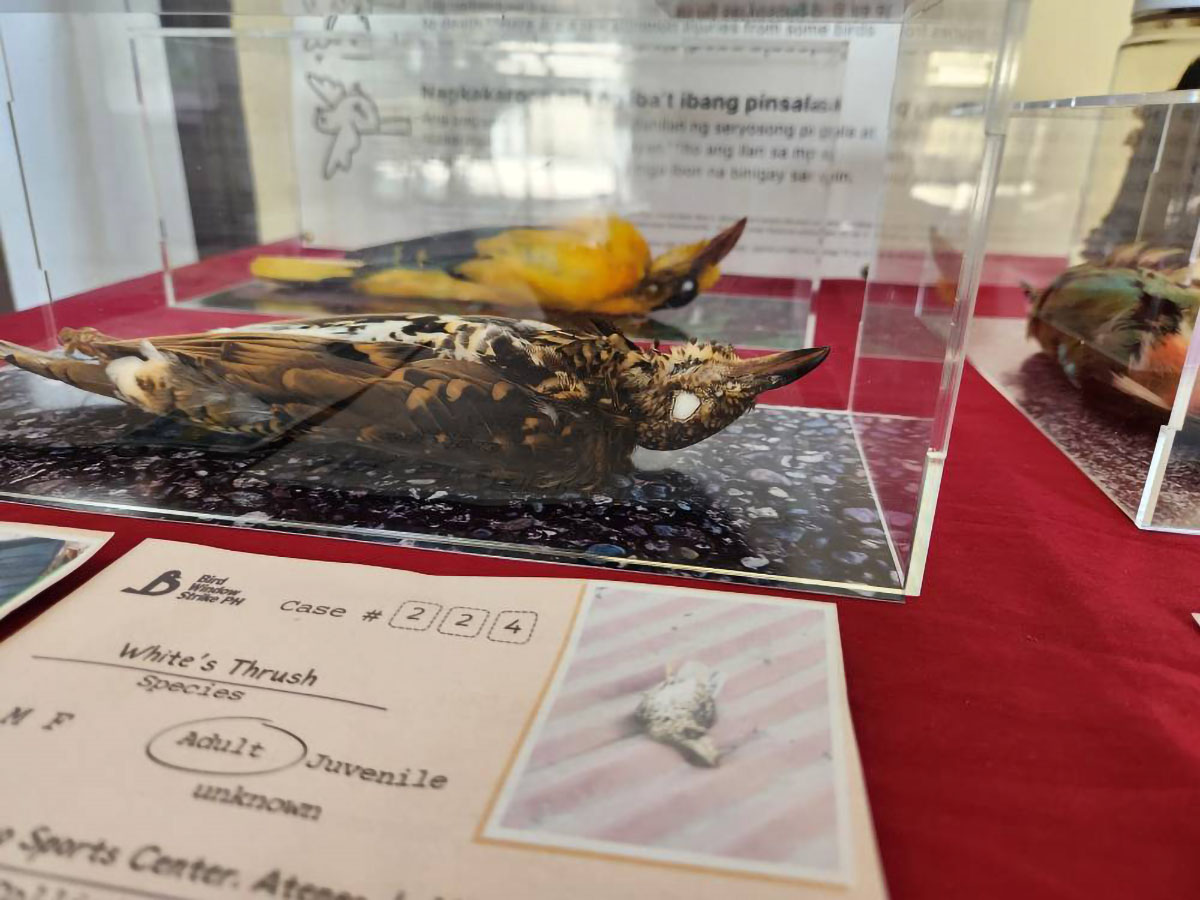
SPECIMEN FOR LEARNING The carcass of a White’s thrush that struck a window is put on display at the recent “Making the Invisible Visible” exhibit at the University of the Philippines Diliman. Through infographics, displays and other bird-window strike remains, the exhibit aimed to bring awareness to and lessen cases of these collisions. PHOTO COURTESY OF BIRD WINDOW STRIKE PH
MANILA, Philippines — Janina Castro, a cat rescuer, had just gotten into bird watching in 2017 when she received an urgent message from a friend who found a stunned bird on the tree-dotted, sprawling campus of the Ateneo de Manila University in Quezon City.
Castro, then taking environmental science at Ateneo, rushed to the scene, picked up the fallen coppersmith barbet and brought it to The Ateneo Wild, a project to raise awareness of the existing flora and fauna on campus.
They all had one theory: a case of a bird-window collision.
READ: Animal rights as humanity’s test
The barbet was found on the grounds of the PLDT-Convergent Technologies Center beside the Ateneo School of Management. The building, which faces an open grass field, features wide and clear windows that also reflect trees and the sky.
The Ateneo campus sprawled on 16 hectares of forested areas and 27 ha of open fields and green spaces is home to at least 70 bird species as well as more than 50 plant species, according to the university website (www.ateneo.edu).
Bird strikes happen when a bird zooms and crashes into clear glass, thinking it’s an extension of vegetation or the sky, according to Castro.
When she found little research about the matter, she enlisted fellow birder, University of the Philippines (UP) instructor Jelaine Gan, to log cases of bird collisions across the country.
READ: World Wildlife Day: Importance of digital tech in protecting species
‘Citizen science’
“When there was that opportunity to get involved in [citizen science], in this case for bird-window strikes, I was really interested,” said Gan, who runs the Facebook page The UP Wild, an online community raising awareness on UP Diliman’s wildlife and green spaces.
Together, they founded Bird Window Strike PH (BWS PH), a citizen science project that collects data to study the occurrence of bird-window strikes across the country, and recommends solutions for Filipino homes. With the help of “citizen scientists” in Ateneo, UP Diliman and others across the country, it has logged 290 cases of bird strikes since 2017.
They found that 60 percent of the cases led to deaths, and that inexperienced, young birds were more susceptible to collisions.
“It happens so much more often than we think. It might happen in your window once, but multiply that by how many houses exist,” Castro said in an interview via Zoom from New Zealand, where she is pursuing a master’s degree in science communication.
Many more cases might have gone unnoticed because the bird survived and flew away, was eaten by predators like cats or snakes, or was hidden or too small to be noticed, according to the researchers.
“We had one incident before: when we retrieved the carcass, the bill crossed because of the impact. The beak bent. It was obviously going fast, and the neck was, of course, broken,” Gan said.
The barbet Castro found on the Ateneo campus in 2017 is one of the “supercollider” species which are more often reported to hit windows than others. Other supercolliders are kingfishers and pittas.
But a third of the reported incidents involved doves and pigeons.
“Most of them (doves) don’t make it because they fly so quickly. They’re such a gorgeous bird, it’s sad to see that many of them collide,” Gan said. “And it’s not unusual. I think in Singapore, it’s also one of their more common birds that collide.”
As modern cities take over forest patches with gleaming high-rises, more birds become vulnerable to collisions with windows.
‘Low-hanging fruit’
Birds are “natural planters.” They play an important role in the dispersal of tree seedlings and forest regeneration, migrating through countries, such as the Philippines. But some die in the concrete jungle.
“These [migratory] birds that fly, they travel so far only to get here and hit the windows. That’s so sad,” Gan said.
In February, BWS PH held a pop-up exhibit, “Making the Invisible Visible,” at the UP Diliman College of Science to call public attention to the common phenomenon.
Solutions to addressing bird collisions are “low-hanging fruit” and inexpensive, the researchers said, citing the idea of “breaking up the reflection” by the nonprofit American Bird Conservancy.
Windows can be blocked or their parts covered with tinted glass, stickers, ropes and mesh. To break the reflection, they can also be painted over, they said.
If one stumbles on a case of a bird strike, he should place the bird in a dark box in a quiet area, and not to feed it to prevent choking.
If the bird gets well in a few hours, it can be released in the area it was found. Otherwise, it should be immediately brought to a veterinarian in a wildlife rescue center.
If the bird dies, its remains can be wrapped in plastic and turned over to research centers, complete with information about the incident.
The public may report cases of bird collisions to BWS PH through facebook.com/BirdWindowStrikePH.